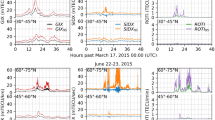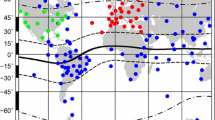Abstract
A new method for modeling the ionospheric delay using global positioning system (GPS) data is proposed, called the ionospheric eclipse factor method (IEFM). It is based on establishing a concept referred to as the ionospheric eclipse factor (IEF) λ of the ionospheric pierce point (IPP) and the IEF’s influence factor (IFF) \(\bar{\lambda}\). The IEF can be used to make a relatively precise distinction between ionospheric daytime and nighttime, whereas the IFF is advantageous for describing the IEF’s variations with day, month, season and year, associated with seasonal variations of total electron content (TEC) of the ionosphere. By combining λ and \(\bar{\lambda}\) with the local time t of IPP, the IEFM has the ability to precisely distinguish between ionospheric daytime and nighttime, as well as efficiently combine them during different seasons or months over a year at the IPP. The IEFM-based ionospheric delay estimates are validated by combining an absolute positioning mode with several ionospheric delay correction models or algorithms, using GPS data at an international Global Navigation Satellite System (GNSS) service (IGS) station (WTZR). Our results indicate that the IEFM may further improve ionospheric delay modeling using GPS data.
Similar content being viewed by others
References
Austen JR, Franke SJ, Liu CH (1988) Ionospheric imaging using computerized tomography. Radio Sci 23(3):299–307
Coster AJ, Foster JC, Ericksion P (2003) Monitoring the ionospheric with GPS. GPS World 14(7):40–45
Dodson AH, Moore T, Aquino MHO, Waugh S (2001) Ionospheric scintillation monitoring in Northern Europe. In: Proceedings the ION GPS-2001, Salt Lake City, pp 2490–2498
El-Arini MB, Conker R, Albertson T, Reegan JK, Klobuchar JA, Doherty P (1995) Comparison of real-time ionospheric algorithms for a GPS wide-area augmentation system (WAAS). Navigation J Inst Navigation 41(4):393–413
Feltens J, Schaer S (1998) IGS products for the ionosphere, IGS position paper. In: Proceedings of the 1998 IGS analysis centers workshop, ESOC, Darmstadt, Germany, 9-11 February, pp 225–232
Fotopoulous G, Cannon ME (2001) An overview of multi-reference station methods for cm-level positioning. GPS Solut 4(3): 1–10
Gao Y, Li Z (1998) Ionosphere effects and modelling for regional area differential GPS network. In: Proceedings the 11th international technical meeting of the satellite division of the US Institute of Navigation, Nashville, Tennessee, pp 91–97
Georgiadiou Y, Kleusberg (1988) On the effect of ionospheric delay on geodetic relative GPS positioning. Manuscr Geod 13:1–8
Georgiadiou Y (1994) Modelling the ionosphere for an active control network of GPS station, LGR-series (7). Delft Geodetic Computing Centre, Delft
Hajj GA, Ibanez-Meier R, Kursinski ER (1994) Imaging the ionosphere with the global positioning system. Int J Imaging Syst Technol 5:174–184
Hernandez-pajares MJ, Juan M, Sanz J, Colombo OL (2000) Application of Ionospheric Tomography to Real-Time GPS carrier Phase Ambiguities Resolution, at Scales of 400–1,000 km and with high geomagnetic activity. Geophys Res Lett 27(13):2009–2012
Hernandez-pajares M (2003) Performance of IGS ionosphere TEC maps, IGS IONO working group report, research group of astronomy and geomatics, Technical University of catalonia g/AGE/UPC), Barcelona, Spain, pp 16
Jakowski N, Schlüter S, Heise H, Feltens J (1999) Auswirkungen der Sonnenfin-sternis vom 11. August 1999 auf die Ionosphäre, Allgemeine Vermessungs-Nachrich-ten (AVN), Wichmann Verlag 11–12:370–373
Klobuchar JA (1987) Ionospheric time delay algorithm for single frequency GPS users. IEEE Trans Aerospace Electron Syst 23(3):325–331
Komjathy A (1997) Global ionospheric total electron content mapping using the global positioning system. PhD Thesis, Technical report no. 188, Department of Geodesy and Geomatics Engineering, the University of New Brunswick
Liu DJ, Guo JJ, Shi YM (1997) Principle and data processing of global positioning system. Press of Tongji University, Shanghai, pp 254–256
Mannucci AJ, Wilson BD, Yuan DN, Ho CH, Lindqwister UJ, Rungem TF (1998) A global mapping technique for GPS-derived ionospheric total electron content measurements. Radio Sci 33:565–577
Ou JK (1996) Atmosphere and its effects on GPS surveying. LGR-Series (14). Delft Geodetic Computing Centre, Delft
Qiu WG, Lachapelle G, Cannon ME (1995) Ionospheric effect modeling for single frequency GPS users. Manuscr Geod 20:96–109
Rizos C, Han S (2003) Reference station network based RTK systems —concepts and progress. Wuhan Univ J Nat Sci 8(2B):566–574
Sardon E, Rius A, Zarraoa N (1994) Ionospheric calibration of single frequency VLBI and GPS observations using dual GPS data. Bull Geod 68:230–235
Skone S (1998) Wide area ionosphere grid modeling in auroral region. PhD Thesis, UCGE Report 20123, Department of Geomatics Engineering, University of Calgary
Skone S, Cannon ME (1999) Adapting the wide area ionospheric grid model for the auroral region. Can Aeronaut Space J 45(3):236–244
Skone S, Cosker A, Hoyle V, Laurin C (2003) WAAS availability and performance at high latitudes. In: Proceedings ION GPS/GNSS-2003, Portland, pp 1279–1287
Wang YJ, Wilkinson P, Caruana J, Wu J (1996) Real-time ionospheric TEC monitoring using GPS. In: Proceedings of the 10th space engineering symposium, Canberra, Australia, 27–29 March 1996, pp 101–111
Wilson BD, Yinger CH, Feess WA, Shank C (1999) New and improved-the broadcast inter-frequency GPS World 10(9):57–66
Wyllie SJ, Zhang KF (2003) A comparison of ionospheric models for precise positioning in Victoria In: Proceedings the 6th international symposium on satellite navigation technology including mobile positioning and location services, pp 1–18
Xiong NL, Tang C, Li Xi (1999) An introduction to ionospheric physics, 1st edn. Wuhan University Press, Wuhan, pp 182–183
Yang YX, He HB, Xu GC (2001) Adaptively robust filtering for kinematic geodetic positioning. J Geod 75(2–3):109–116
Yuan YB, Ou KJ (1999) The effects of instrumental bias in GPS observation on determining ionospheric delays and the methods of its calibration. Acta Geodaetca Cartogr Sin 28(2):110–114
Yuan YB, Ou JK (2001) An improvement on ionospheric delay correction for single frequency GPS user—the APR-I scheme. J Geod 75(5/6):331–336
Yuan YB, Ou JK (2002) Differential areas for differential stations (DADS): a new method of establishing grid ionospheric model. Chin Sci Bull 47(12):1033–1036
Yuan YB, Ou JK (2004) Ionospheric Eclipse Factor Method (IEFM) for determining the Ionospheric Delay Using GPS Data. Prog Nat Sci 14(9):800–804
Zhang KF, Roberts C (2003) Network-based real-time kinematic positioning system: current research in Australia. In: Proceedings of geoinformatics and surveying conference, pp 1–12
Author information
Authors and Affiliations
Corresponding author
Rights and permissions
About this article
Cite this article
Yuan, Y., Tscherning, C.C., Knudsen, P. et al. The ionospheric eclipse factor method (IEFM) and its application to determining the ionospheric delay for GPS. J Geod 82, 1–8 (2008). https://doi.org/10.1007/s00190-007-0152-2
Received:
Accepted:
Published:
Issue Date:
DOI: https://doi.org/10.1007/s00190-007-0152-2




